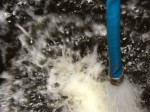The wind gusted overnight up to 28 knots from the west. It decreased in the early hours and switched around to the northeast, blowing between 6 and 17 knots. The barometer rose slightly in the first half of the day, from 1019 hPa to 1024 hPa at 11:00, afterwards dropping to 1020 hPa. There was a light rain for most of the daylight hours, with low cloud cover and fog looming around Race Rocks. The visibility was between 1 and 2 nautical miles. In the evening, the visibility increased between the periods of rain.
There were no boats seen in the reserve today.
The fire pump got a good nonemergency workout today, running for several hours to fill up the salt water cistern. The cistern feeds the desalinator, which hydrates me and other humans on Race Rocks. The ominous fog convinced me that it was a good idea to wear ear protection whenever I was on the south side of the island, where the fog horn is located. I was worried about the sea lions being startled by the fog horn, that I was sure would go off at any moment. Obviously, they knew better than me since the fog never reached Race Rocks. There is an instrument half way up the tower that reads how light passes through air, switching on the high pitched fog horn when necessary. The ear protection is quite comfortable, like earmuffs. I caught myself wearing them when I was nowhere near the fog horn. Ready for the fog horn and rain, I zigzagged all over the island doing work: getting rid of the algae on exterior walls, topping up the batteries with the generator, testing the salinity of the sea water, sweeping the goose poop off the paths, picking up garbage that washed ashore, moving things, and doing my best to fix broken things.
- Sea water is pumped into the underground salt water cistern.
- These fog horn sits near the base of the lighthouse, facing south into the Juan de Fuca Strait. Steller and california sea lions gather nearby on South Seal Rocks.


